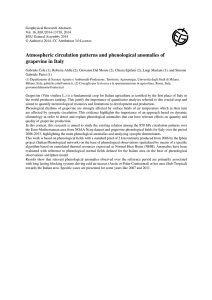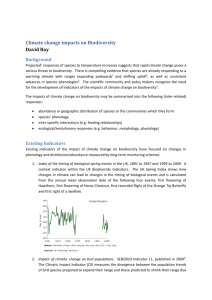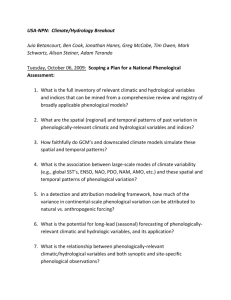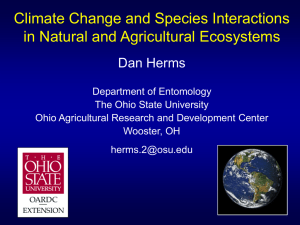August, 2014 - USA National Phenology Network
advertisement
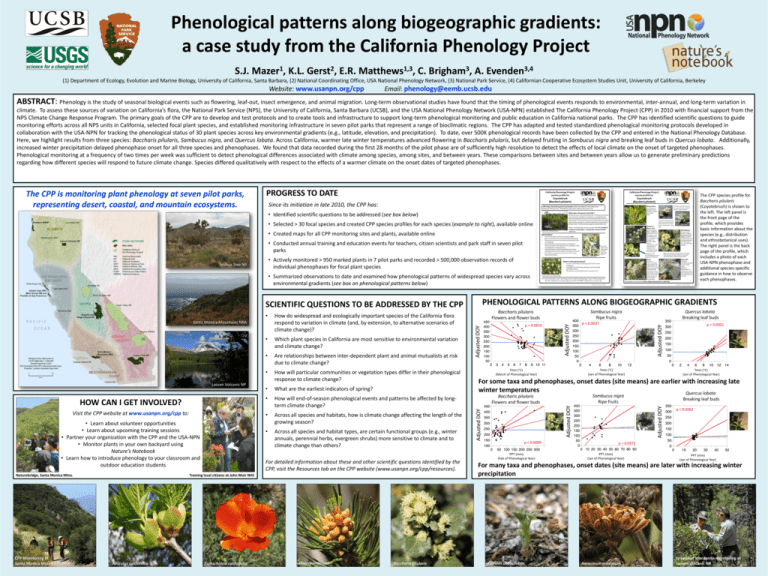
Phenological patterns along biogeographic gradients: a case study from the California Phenology Project S.J. 1 Mazer , K.L. 2 Gerst , E.R. 1,3 Matthews , C. 3 Brigham , A. 3,4 Evenden (1) Department of Ecology, Evolution and Marine Biology, University of California, Santa Barbara, (2) National Coordinating Office, USA National Phenology Network, (3) National Park Service, (4) Californian Cooperative Ecosystem Studies Unit, University of California, Berkeley Website: www.usanpn.org/cpp Email: phenology@eemb.ucsb.edu ABSTRACT: Phenology is the study of seasonal biological events such as flowering, leaf-out, insect emergence, and animal migration. Long-term observational studies have found that the timing of phenological events responds to environmental, inter-annual, and long-term variation in climate. To assess these sources of variation on California’s flora, the National Park Service (NPS), the University of California, Santa Barbara (UCSB), and the USA National Phenology Network (USA-NPN) established The California Phenology Project (CPP) in 2010 with financial support from the NPS Climate Change Response Program. The primary goals of the CPP are to develop and test protocols and to create tools and infrastructure to support long-term phenological monitoring and public education in California national parks. The CPP has identified scientific questions to guide monitoring efforts across all NPS units in California, selected focal plant species, and established monitoring infrastructure in seven pilot parks that represent a range of bioclimatic regions. The CPP has adapted and tested standardized phenological monitoring protocols developed in collaboration with the USA-NPN for tracking the phenological status of 30 plant species across key environmental gradients (e.g., latitude, elevation, and precipitation). To date, over 500K phenological records have been collected by the CPP and entered in the National Phenology Database. Here, we highlight results from three species: Baccharis pilularis, Sambucus nigra, and Quercus lobata. Across California, warmer late winter temperatures advanced flowering in Baccharis pilularis, but delayed fruiting in Sambucus nigra and breaking leaf buds in Quercus lobata. Additionally, increased winter precipitation delayed phenophase onset for all three species and phenophases. We found that data recorded during the first 28 months of the pilot phase are of sufficiently high resolution to detect the effects of local climate on the onset of targeted phenophases. Phenological monitoring at a frequency of two times per week was sufficient to detect phenological differences associated with climate among species, among sites, and between years. These comparisons between sites and between years allow us to generate preliminary predictions regarding how different species will respond to future climate change. Species differed qualitatively with respect to the effects of a warmer climate on the onset dates of targeted phenophases. The CPP is monitoring plant phenology at seven pilot parks, representing desert, coastal, and mountain ecosystems. PROGRESS TO DATE The CPP species profile for Baccharis pilularis (Coyotebrush) is shown to the left. The left panel is the front page of the profile, which provides basic information about the species (e.g., distribution and ethnobotanical uses). The right panel is the back page of the profile, which includes a photo of each USA-NPN phenophase and additional species-specific guidance in how to observe each phenophases. Since its initiation in late 2010, the CPP has: • Identified scientific questions to be addressed (see box below) • Selected > 30 focal species and created CPP species profiles for each species (example to right), available online photos • Created maps for all CPP monitoring sites and plants, available online • Conducted annual training and education events for teachers, citizen scientists and park staff in seven pilot parks • Actively monitored > 950 marked plants in 7 pilot parks and recorded > 500,000 observation records of individual phenophases for focal plant species Joshua Tree NP • Summarized observations to date and examined how phenological patterns of widespread species vary across environmental gradients (see box on phenological patterns below) PHENOLOGICAL PATTERNS ALONG BIOGEOGRAPHIC GRADIENTS Visit the CPP website at www.usanpn.org/cpp to: • Learn about volunteer opportunities • Learn about upcoming training sessions • Partner your organization with the CPP and the USA-NPN • Monitor plants in your own backyard using Nature’s Notebook • Learn how to introduce phenology to your classroom and outdoor education students Naturebridge, Santa Monica Mtns. CPP Monitoring at Santa Monica Mountains NRA • How will particular communities or vegetation types differ in their phenological response to climate change? • What are the earliest indicators of spring? • How will end-of-season phenological events and patterns be affected by longterm climate change? • Across all species and habitats, how is climate change affecting the length of the growing season? • Across all species and habitat types, are certain functional groups (e.g., winter annuals, perennial herbs, evergreen shrubs) more sensitive to climate and to climate change than others? For detailed information about these and other scientific questions identified by the CPP, visit the Resources tab on the CPP website (www.usanpn.org/cpp/resources). Training local citizens at John Muir NHS Aesculus californica Eschscholzia californica Pinus ponderosa Baccharis pilularis Adjusted DOY Are relationships between inter-dependent plant and animal mutualists at risk due to climate change? Adjusted DOY • p < 0.0037 Quercus lobata Breaking leaf buds Tmin (°C) (Jan of Phenological Year) Tmin (°C) (March of Phenological Year) p < 0.0001 Tmin (°C) (Jan of Phenological Year) For some taxa and phenophases, onset dates (site means) are earlier with increasing late Look winter temperatures Quercus lobata Sambucus nigra Ripe fruits Baccharis pilularis Flowers and flower buds p < 0.0009 PPT (mm) (Feb of Phenological Year) Breaking leaf buds Adjusted DOY HOW CAN I GET INVOLVED? Which plant species in California are most sensitive to environmental variation and climate change? p < 0.0010 Adjusted DOY Lassen Volcanic NP • Adjusted DOY Santa Monica Mountains NRA How do widespread and ecologically important species of the California flora respond to variation in climate (and, by extension, to alternative scenarios of climate change)? Sambucus nigra Ripe fruits Baccharis pilularis Flowers and flower buds Adjusted DOY SCIENTIFIC QUESTIONS TO BE ADDRESSED BY THE CPP • Santa Monica Mountains NRA p < 0.0362 p < 0.0372 PPT (mm) (Jan of Phenological Year) PPT (mm) (Jan of Phenological Year) For many taxa and phenophases, onset dates (site means) are later with increasing winter precipitation Lupinus obtusilobus Heracleum maximum Greenleaf manzanita monitoring at Lassen Volcanic NP




